Page 68 of 394
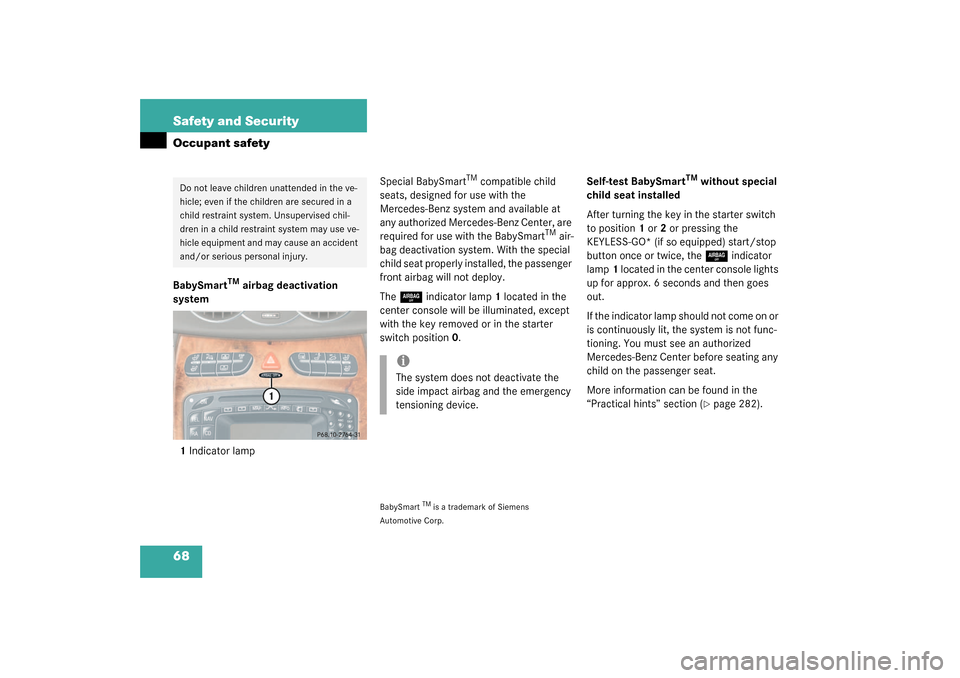
68 Safety and SecurityOccupant safetyBabySmart
TM
airbag deactivation
system
1Indicator lampSpecial BabySmart
TM compatible child
seats, designed for use with the
Mercedes-Benz system and available at
any authorized Mercedes-Benz Center, are
required for use with the BabySmart
TM air-
bag deactivation system. With the special
child seat properly installed, the passenger
front airbag will not deploy.
The
7
indicator lamp1 located in the
center console will be illuminated, except
with the key removed or in the starter
switch position0.
BabySmart
TM is a trademark of Siemens
Automotive Corp.
Self-test BabySmart
TM
without special
child seat installed
After turning the key in the starter switch
to position1 or2 or pressing the
KEYLESS-GO* (if so equipped) start/stop
button once or twice, the 7
indicator
lamp1 located in the center console lights
up for approx. 6 seconds and then goes
out.
If the indicator lamp should not come on or
is continuously lit, the system is not func-
tioning. You must see an authorized
Mercedes-Benz Center before seating any
child on the passenger seat.
More information can be found in the
“Practical hints” section (
�page 282).
Do not leave children unattended in the ve-
hicle; even if the children are secured in a
child restraint system. Unsupervised chil-
dren in a child restraint system may use ve-
hicle equipment and may cause an accident
and/or serious personal injury.
iThe system does not deactivate the
side impact airbag and the emergency
tensioning device.
Page 69 of 394
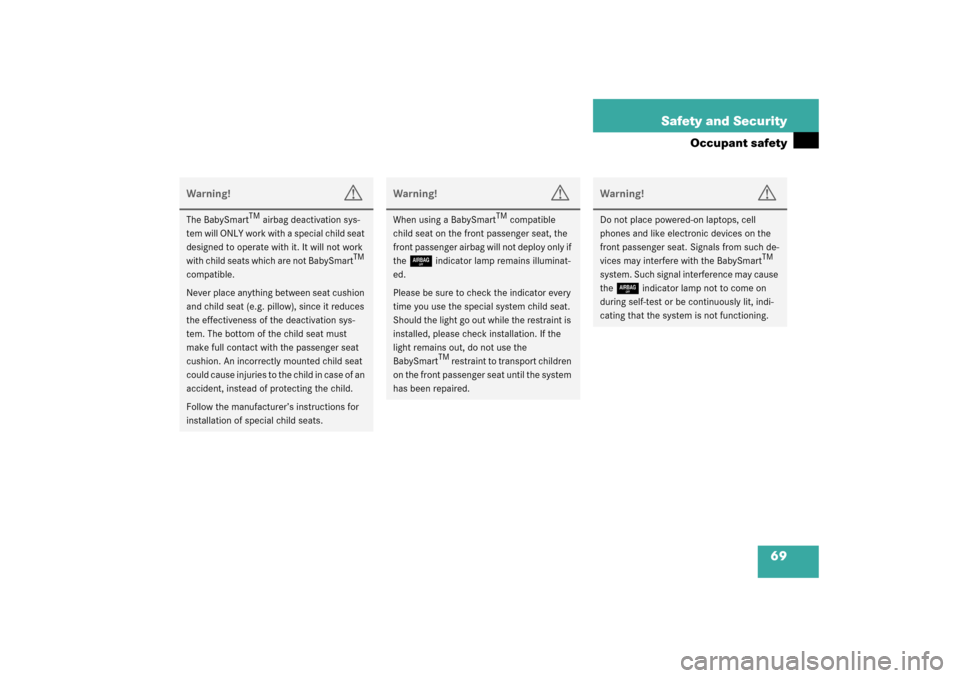
69 Safety and Security
Occupant safety
Warning!
G
The BabySmart
TM airbag deactivation sys-
tem will ONLY work with a special child seat
designed to operate with it. It will not work
with child seats which are not BabySmart
TM
compatible.
Never place anything between seat cushion
and child seat (e.g. pillow), since it reduces
the effectiveness of the deactivation sys-
tem. The bottom of the child seat must
make full contact with the passenger seat
cushion. An incorrectly mounted child seat
could cause injuries to the child in case of an
accident, instead of protecting the child.
Follow the manufacturer’s instructions for
installation of special child seats.
Warning!
G
When using a BabySmart
TM compatible
child seat on the front passenger seat, the
front passenger airbag will not deploy only if
the
7
indicator lamp remains illuminat-
ed.
Please be sure to check the indicator every
time you use the special system child seat.
Should the light go out while the restraint is
installed, please check installation. If the
light remains out, do not use the
BabySmartTM restraint to transport children
on the front passenger seat until the system
has been repaired.
Warning!
G
Do not place powered-on laptops, cell
phones and like electronic devices on the
front passenger seat. Signals from such de-
vices may interfere with the BabySmart
TM
system. Such signal interference may cause
the
7
indicator lamp not to come on
during self-test or be continuously lit, indi-
cating that the system is not functioning.
Page 74 of 394
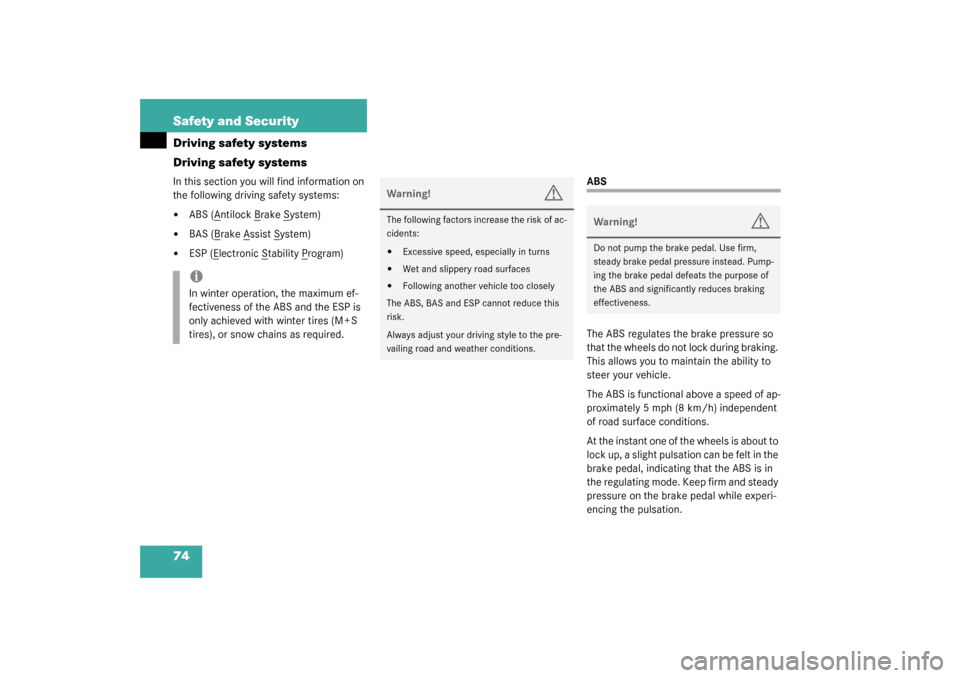
74 Safety and SecurityDriving safety systems
Driving safety systemsIn this section you will find information on
the following driving safety systems:�
ABS (A
ntilock B
rake S
ystem)
�
BAS (B
rake A
ssist S
ystem)
�
ESP (E
lectronic S
tability P
rogram)
ABS
The ABS regulates the brake pressure so
that the wheels do not lock during braking.
This allows you to maintain the ability to
steer your vehicle.
The ABS is functional above a speed of ap-
proximately 5 mph (8 km/h) independent
of road surface conditions.
At the instant one of the wheels is about to
lock up, a slight pulsation can be felt in the
brake pedal, indicating that the ABS is in
the regulating mode. Keep firm and steady
pressure on the brake pedal while experi-
encing the pulsation.
iIn winter operation, the maximum ef-
fectiveness of the ABS and the ESP is
only achieved with winter tires (M + S
tires), or snow chains as required.
Warning!
G
The following factors increase the risk of ac-
cidents:�
Excessive speed, especially in turns
�
Wet and slippery road surfaces
�
Following another vehicle too closely
The ABS, BAS and ESP cannot reduce this
risk.
Always adjust your driving style to the pre-
vailing road and weather conditions.
Warning!
G
Do not pump the brake pedal. Use firm,
steady brake pedal pressure instead. Pump-
ing the brake pedal defeats the purpose of
the ABS and significantly reduces braking
effectiveness.
Page 75 of 394
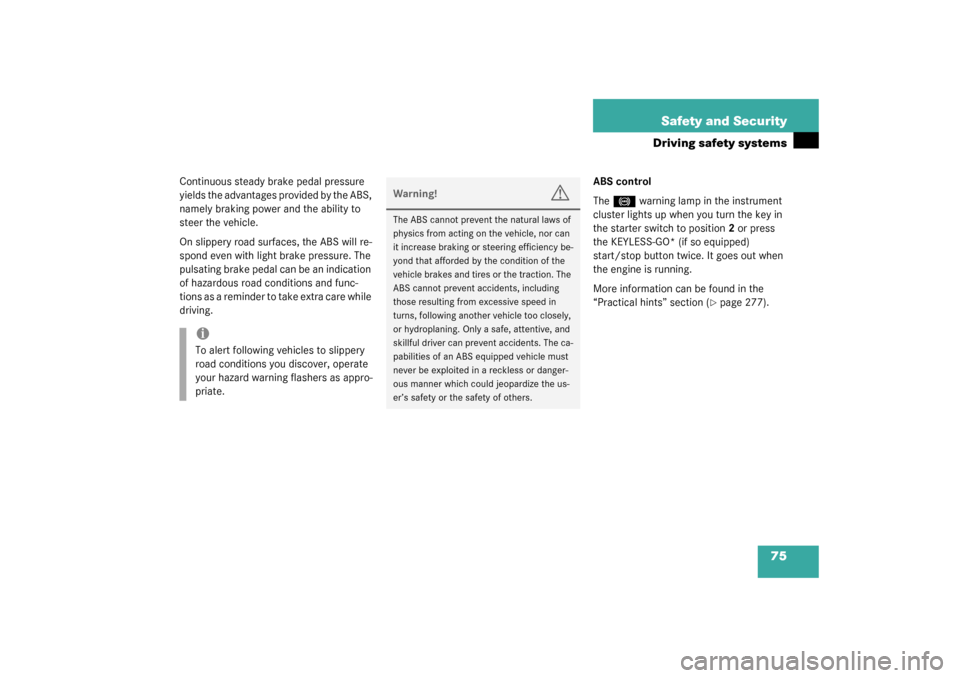
75 Safety and Security
Driving safety systems
Continuous steady brake pedal pressure
yields the advantages provided by the ABS,
namely braking power and the ability to
steer the vehicle.
On slippery road surfaces, the ABS will re-
spond even with light brake pressure. The
pulsating brake pedal can be an indication
of hazardous road conditions and func-
tions as a reminder to take extra care while
driving.ABS control
The
-
warning lamp in the instrument
cluster lights up when you turn the key in
the starter switch to position2 or press
the KEYLESS-GO* (if so equipped)
start/stop button twice. It goes out when
the engine is running.
More information can be found in the
“Practical hints” section (
�page 277).
iTo alert following vehicles to slippery
road conditions you discover, operate
your hazard warning flashers as appro-
priate.
Warning!
G
The ABS cannot prevent the natural laws of
physics from acting on the vehicle, nor can
it increase braking or steering efficiency be-
yond that afforded by the condition of the
vehicle brakes and tires or the traction. The
ABS cannot prevent accidents, including
those resulting from excessive speed in
turns, following another vehicle too closely,
or hydroplaning. Only a safe, attentive, and
skillful driver can prevent accidents. The ca-
pabilities of an ABS equipped vehicle must
never be exploited in a reckless or danger-
ous manner which could jeopardize the us-
er’s safety or the safety of others.
Page 76 of 394
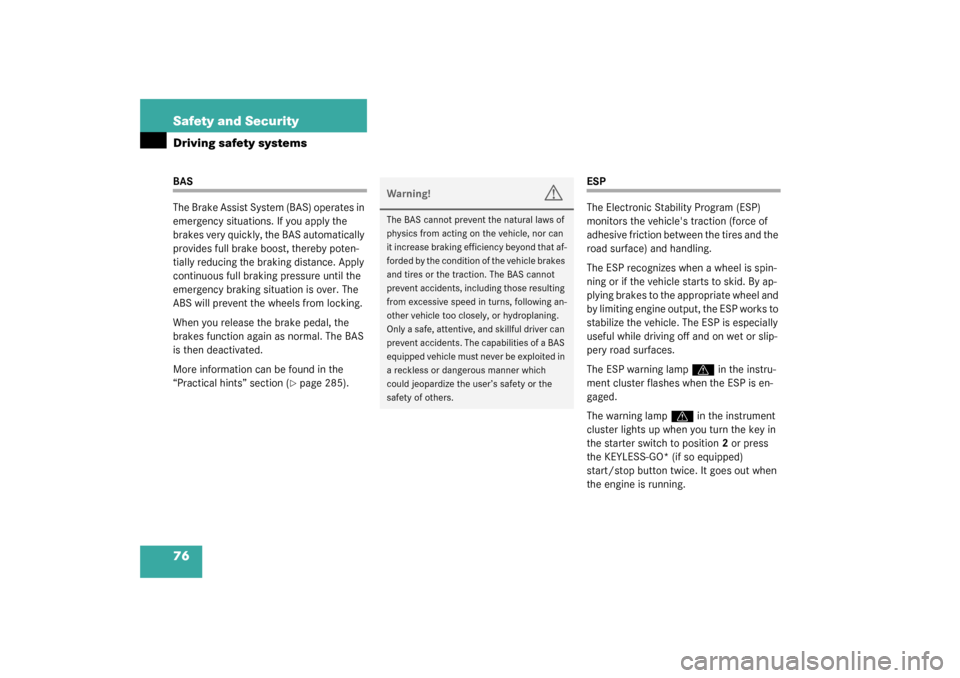
76 Safety and SecurityDriving safety systemsBAS
The Brake Assist System (BAS) operates in
emergency situations. If you apply the
brakes very quickly, the BAS automatically
provides full brake boost, thereby poten-
tially reducing the braking distance. Apply
continuous full braking pressure until the
emergency braking situation is over. The
ABS will prevent the wheels from locking.
When you release the brake pedal, the
brakes function again as normal. The BAS
is then deactivated.
More information can be found in the
“Practical hints” section (
�page 285).
ESP
The Electronic Stability Program (ESP)
monitors the vehicle's traction (force of
adhesive friction between the tires and the
road surface) and handling.
The ESP recognizes when a wheel is spin-
ning or if the vehicle starts to skid. By ap-
plying brakes to the appropriate wheel and
by limiting engine output, the ESP works to
stabilize the vehicle. The ESP is especially
useful while driving off and on wet or slip-
pery road surfaces.
The ESP warning lamp
v
in the instru-
ment cluster flashes when the ESP is en-
gaged.
The warning lamp
v
in the instrument
cluster lights up when you turn the key in
the starter switch to position2 or press
the KEYLESS-GO* (if so equipped)
start/stop button twice. It goes out when
the engine is running.
Warning!
G
The BAS cannot prevent the natural laws of
physics from acting on the vehicle, nor can
it increase braking efficiency beyond that af-
forded by the condition of the vehicle brakes
and tires or the traction. The BAS cannot
prevent accidents, including those resulting
from excessive speed in turns, following an-
other vehicle too closely, or hydroplaning.
Only a safe, attentive, and skillful driver can
prevent accidents. The capabilities of a BAS
equipped vehicle must never be exploited in
a reckless or dangerous manner which
could jeopardize the user’s safety or the
safety of others.
Page 81 of 394
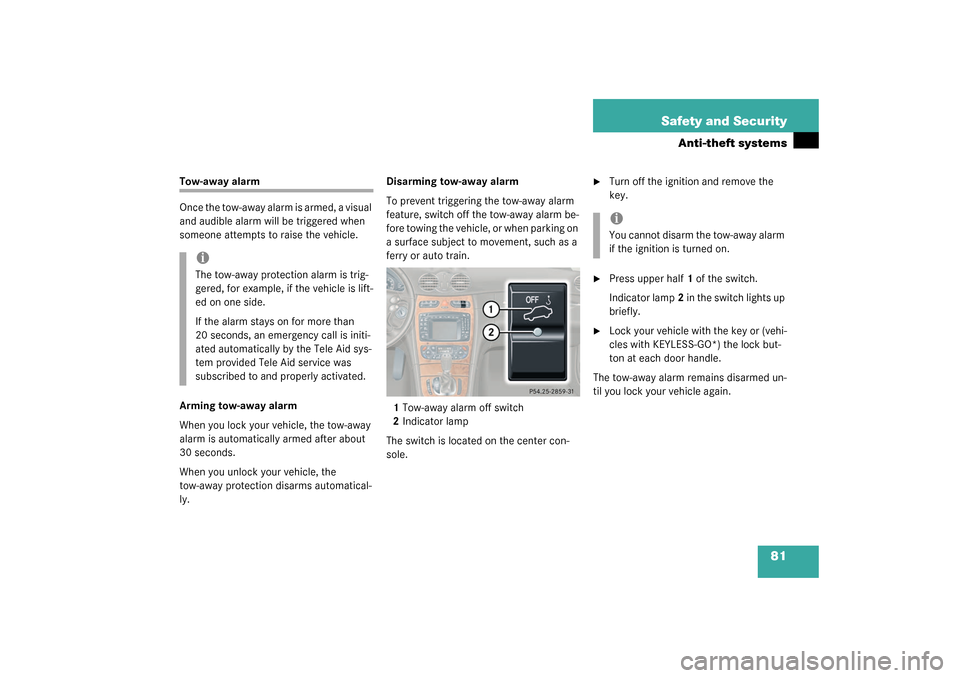
81 Safety and Security
Anti-theft systems
Tow-away alarm
Once the tow-away alarm is armed, a visual
and audible alarm will be triggered when
someone attempts to raise the vehicle.
Arming tow-away alarm
When you lock your vehicle, the tow-away
alarm is automatically armed after about
30 seconds.
When you unlock your vehicle, the
tow-away protection disarms automatical-
ly.Disarming tow-away alarm
To prevent triggering the tow-away alarm
feature, switch off the tow-away alarm be-
fore towing the vehicle, or when parking on
a surface subject to movement, such as a
ferry or auto train.
1Tow-away alarm off switch
2Indicator lamp
The switch is located on the center con-
sole.
�
Turn off the ignition and remove the
key.
�
Press upper half1 of the switch.
Indicator lamp2 in the switch lights up
briefly.
�
Lock your vehicle with the key or (vehi-
cles with KEYLESS-GO*) the lock but-
ton at each door handle.
The tow-away alarm remains disarmed un-
til you lock your vehicle again.
iThe tow-away protection alarm is trig-
gered, for example, if the vehicle is lift-
ed on one side.
If the alarm stays on for more than
20 seconds, an emergency call is initi-
ated automatically by the Tele Aid sys-
tem provided Tele Aid service was
subscribed to and properly activated.
iYou cannot disarm the tow-away alarm
if the ignition is turned on.
Page 83 of 394
83 Controls in detail
Locking and unlocking
Seats
Memory function
Lighting
Instrument cluster
Control system
Automatic transmission
Good visibility
Automatic climate control
Audio system
Power windows
Sliding/pop-up roof*
Driving systems
Loading
Useful features
Page 86 of 394
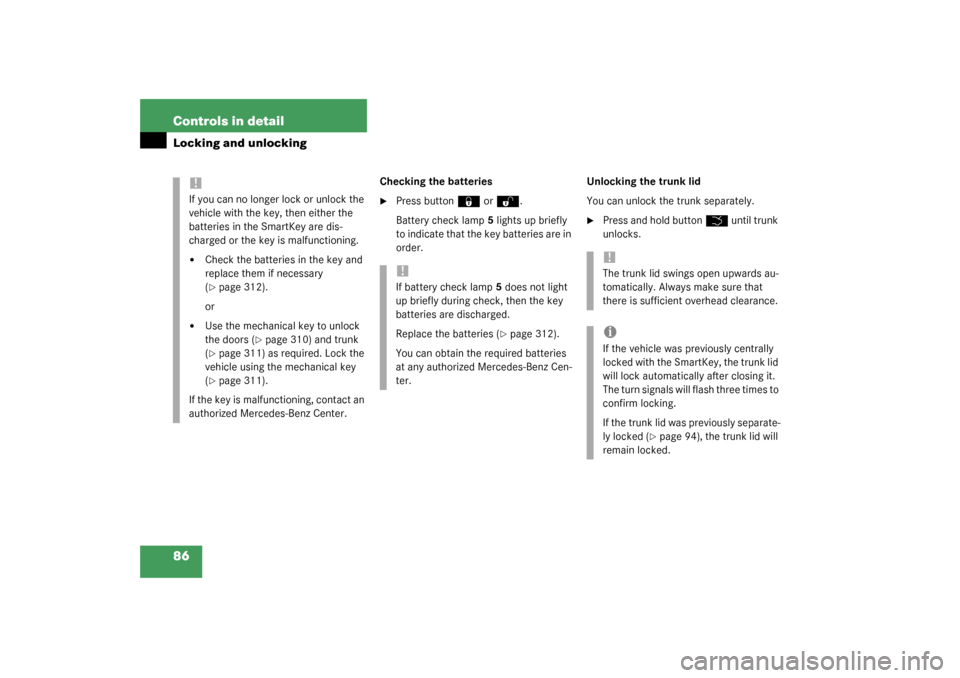
86 Controls in detailLocking and unlocking
Checking the batteries�
Press button
‹
or
Œ
.
Battery check lamp5 lights up briefly
to indicate that the key batteries are in
order.Unlocking the trunk lid
You can unlock the trunk separately.
�
Press and hold button
Š
until trunk
unlocks.
!If you can no longer lock or unlock the
vehicle with the key, then either the
batteries in the SmartKey are dis-
charged or the key is malfunctioning.�
Check the batteries in the key and
replace them if necessary
(�page 312).
or
�
Use the mechanical key to unlock
the doors (
�page 310) and trunk
(
�page 311) as required. Lock the
vehicle using the mechanical key
(�page 311).
If the key is malfunctioning, contact an
authorized Mercedes-Benz Center.
!If battery check lamp5 does not light
up briefly during check, then the key
batteries are discharged.
Replace the batteries (
�page 312).
You can obtain the required batteries
at any authorized Mercedes-Benz Cen-
ter.
!The trunk lid swings open upwards au-
tomatically. Always make sure that
there is sufficient overhead clearance.iIf the vehicle was previously centrally
locked with the SmartKey, the trunk lid
will lock automatically after closing it.
The turn signals will flash three times to
confirm locking.
If the trunk lid was previously separate-
ly locked (
�page 94), the trunk lid will
remain locked.